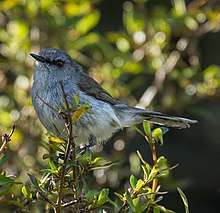Grey warbler
The grey warbler (Gerygone igata), also known by its Māori name riroriro[2] or outside New Zealand as the grey gerygone, is an insectivorous bird in the family Acanthizidae endemic to New Zealand. Its natural habitat is temperate forests. It is sometimes known as the teetotum or rainbird.[3]
| Grey warbler | |
|---|---|
 | |
| Scientific classification | |
| Kingdom: | Animalia |
| Phylum: | Chordata |
| Class: | Aves |
| Order: | Passeriformes |
| Family: | Acanthizidae |
| Genus: | Gerygone |
| Species: | G. igata |
| Binomial name | |
| Gerygone igata | |
| Synonyms | |
| |
Description
Song
The male's song often starts with a series of three squeaks and builds into a distinc, during spring. Grey warblers are often heard more than they are seen.
Distribution and habitat
Grey warblers are common throughout New Zealand's main islands and many off-shore islands, but are absent from open country and alpine areas. At home in native and exotic forests it may be found almost anywhere there is some tree or shrub cover.[4]
Behaviour
Diet
Grey warblers mainly feed upon spiders, insects and their larvae. They are very active, and almost never stay still as they move from one perch to another.
Nesting

Grey warblers are unique among New Zealand birds in building a pear-shaped nest with a side entrance near the top. The male collects nesting material, but the female builds the nest from grass, leaves, rootlets and moss, held together with spider web threads, anywhere from 2 to 25 feet above the ground, lined with feathers and other soft material. It is attached to a twig at the top, but is often also secured at the back or sides. The male is not involved in nest building or incubation, but helps to feed nestlings and fledglings. The 3 to 6 eggs, each laid 2 days apart, are pinkish-white with fine reddish-brown speckles all over. The eggs, weighing 1.5 grams are about 17 millimetres long and 12 millimetres wide. Incubation takes about 19 days and the chicks spend another 15 to 19 days in the nest.
Their breeding season is from August to January and they usually manage two clutches. The shining bronze cuckoo, a brood parasite, often targets the second clutch.[5]
In Māori culture
The direction in which a grey warbler would build its nest served as an indicator of forthcoming weather conditions to Māori – in this respect, the bird was known as a manu tohu tau.[6] The tradition states that a grey warbler will build the nest entrance in the opposite direction to the prevailing wind.[7] As such, a eastern-facing entrance would indicate a poorly season brought on by western winds; in contrast, a northern-facing entrance would suggest a pleasant season ahead.[6]
In spring, the song of the grey warbler is said to be a signal for Māori to begin planting their crops.[8] As such, those whose 'ignore' the call of the grey warbler and do not help out with the planting of crops (and later seek to reap the harvest for themselves) are rebuked with the following whakataukī (proverb):
I whea koe i te tangihanga o te riroriro, ka mahi kai māu?
Where were you when the riroriro was singing, that you didn’t work to get yourself food?[7]
References
- BirdLife International (2012). "Gerygone igata". IUCN Red List of Threatened Species. 2012. Retrieved 26 November 2013.CS1 maint: ref=harv (link)
- TPH 7/7/1905 p3 http://www.maoridictionary.co.nz/search?idiom=&phrase=&proverb=&loan=&keywords=Riroriro&search=
- Grey warbler - New Zealand Birds Online http://nzbirdsonline.org.nz/species/grey-warbler
- Atlas Of Bird Distribution In New Zealand 1999–2004 - Ornithological Society of New Zealand http://notornis.osnz.org.nz/bird-distribution-atlas-1999-2004-last-gasp-field
- Davies, Nick (2010). Cuckoos, Cowbirds and Other Cheats. A&C Black. p. 94. ISBN 1408135868.
- Best, E. (1977). Forest lore of the Maori. Wellington, New Zealand: E.C. Keating.
- Keane-Tuala, K. (2015). "Ngā manu – birds - Predicting the weather". Te Ara. Retrieved 2020-06-13.
- Metge, J. (2015). Tauira: Māori methods of learning and teaching. Auckland, New Zealand: Auckland University Press.
- NZ Royal Forest and Bird Protection Society, Nov 2003
- Gerygone Flaviventris. — (Grey Warbler.) | NZETC
| Wikimedia Commons has media related to Gerygone igata. |

